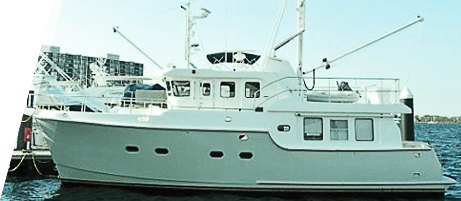[wpseo_breadcrumb]
By The Numbers
One does not want just another “trawler” or regular yacht with beauty and sturdiness that probably won’t even last a few years. To ensure utmost safety and exceptional performance, understanding and following fundamental rules in building a boat will determine the needs of a particular owner. Some simply want to go fishing during the weekend while other boat buyers are interested in long distance sailing.
The basic principles that must be taken into consideration are Displacement/Length Ratio (D/L), Speed/Length Ratio (S/L) and the Above Water/Below Water Ratio (A/B).
Displacement/Length Ratio (D/L)
You need a heavier boat if you wish to have more room for storage, accommodation, fuel for longer trips and more. Moreover, bigger and heavier boats offer more comfort when sailing rough seas. The ratio of displacement to length (D/L) separates those who simply try to ride the yacht bandwagon from the serious passagemakers. For long-range cruising that’s self-sufficient, a boat must have sufficient volume, and when D/L is too low, it just won’t work. If the vessel is short, the D/L must be higher in order to carry enough loads. It is important to note that a boat must be fully loaded when calculating D/L. Generally, a 50-foot boat range should have a D/L of 270 and above. For example, the D/L of a Nordhavn 55 is 365.
Ensure that you have the correct formula in calculating D/L. Start with the long tons in a boat’s displacement (DLT). A ton is equal to 2,240 pounds. From there, multiply the LWL or your boat’s loaded water line by 0.01 and the result must be cubed. Divide this result into the DLT. To simplify, this is the formula: D/L = DLT ÷ (0.01 x LWL) 3.
Example: Nordhavn 55 with an 115,000-pound displacement and 50’10” (50.83ft) LWL.
DLT = 115,000/2240 (tons) = 51.3
0.02 x 50.83 = 0.1414
To get the final D/L: 51.3/.1313 = 391
D/L = 391
Some boats save on weight by building with less sturdy material. A larger boat can be built using scantlings that are heavy-duty without worrying about its weight. One must remember that if a boat is heavily built, it can carry more passengers, supplies, and equipment and will be more comfortable while sailing rough seas and will be more durable to natural wear and tear.
Speed/Length Ratio (S/L)
An S/L of l.34 is equated to the theoretical hull speed, which is the basic knowledge that one must understand when it comes to S/L or speed to length ration. You must not go above this speed unless a lot of additional power is applied. A wave as long as long as a hull’s waterline is also made at this speed. The hull speed is higher if the boat is longer.
If your boat’s SL is l.34, multiply this by the square root of your boat’s waterline to determine the hull speed. The greatest distance range is provided by speed that’s slightly lower than the hull speed. A ratio of S/L between l.1 and l.2 is said to offer the most efficient horsepower and speed looking at the typical range curve, power or speed. Especially if you are concerned with your fuel consumptions, you must remember that even small changes in speed can make huge changes in the consumption of fuel. A boat with a 50-foot waterline has a hull speed of 9.46 knots and will be most efficient in operation in the range of 7.8 to 8.5 knots. The formula above for a 50-foot waterline boat simplified is (l.34 x square root of 50).
Above Water/Below Water Ratio (A/B) Most actual fishing trawlers who regularly sail to the ocean have A/B ratios under 2. However, a yacht may have a difficult time to achieve this especially those with large topside accommodations. P.A.E. suggests that oceangoing passagemakers may strive for 2.l to 2.7 A/B ratios. As a matter of fact, it is said that there are many boats that are “trawler styled” which have become popular in the market today that have A/B ratios above 4. One must know that this inadequate and actually may also be dangerous. A/B can easily be seen from a boat’s side. The area is the part above the water, and the B area is the part below the water.
Most actual fishing trawlers who regularly sail to the ocean have A/B ratios under 2. However, a yacht may have a difficult time to achieve this especially those with large topside accommodations. P.A.E. suggests that oceangoing passagemakers may strive for 2.l to 2.7 A/B ratios. As a matter of fact, it is said that there are many boats that are “trawler styled” which have become popular in the market today that have A/B ratios above 4. One must know that this inadequate and actually may also be dangerous. A/B can easily be seen from a boat’s side. The area is the part above the water, and the B area is the part below the water.
CONSTRUCTION FUNDAMENTALS
Yacht Tech can provide you brokerage solutions to sell your Used Nordhavn at a fair price.
